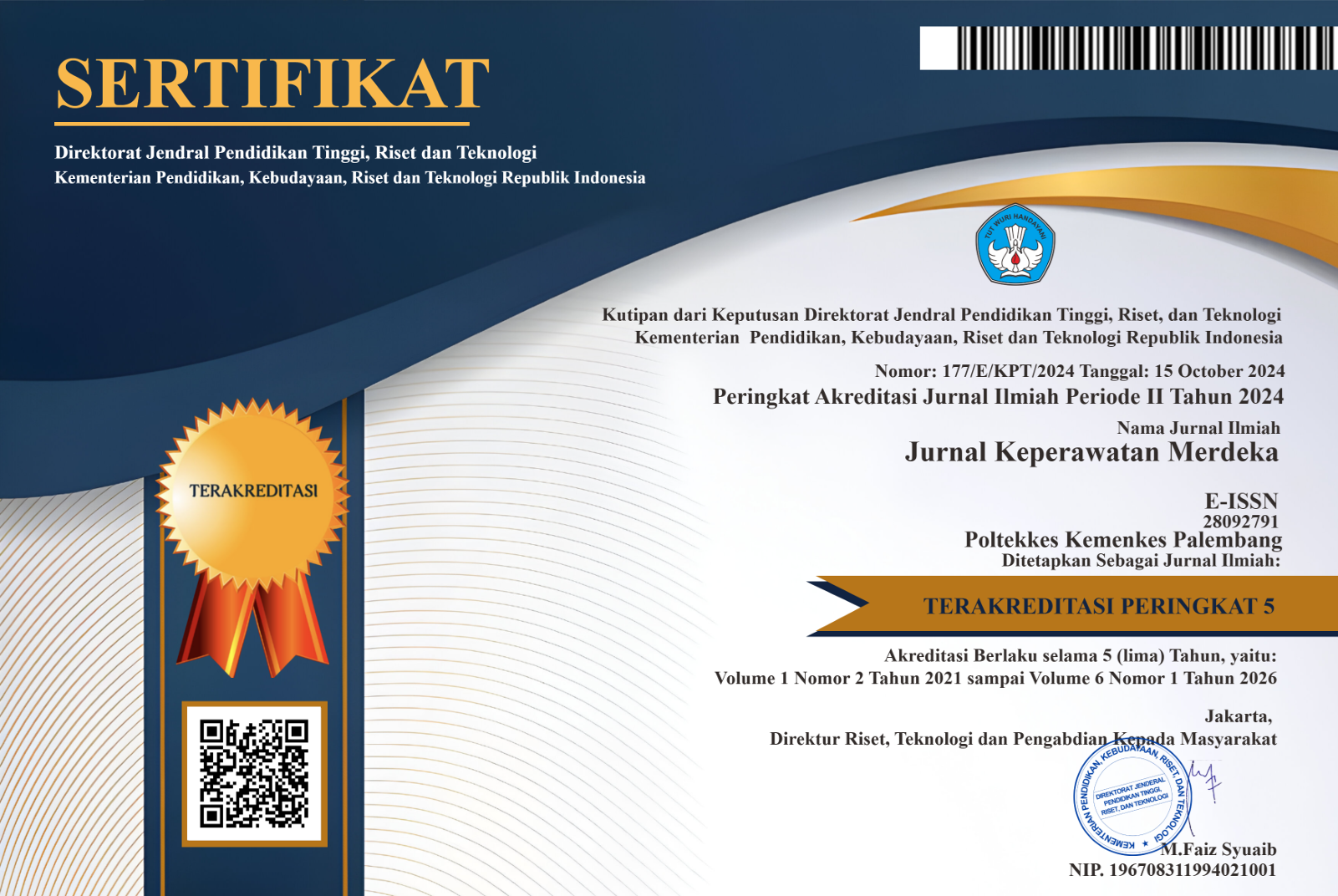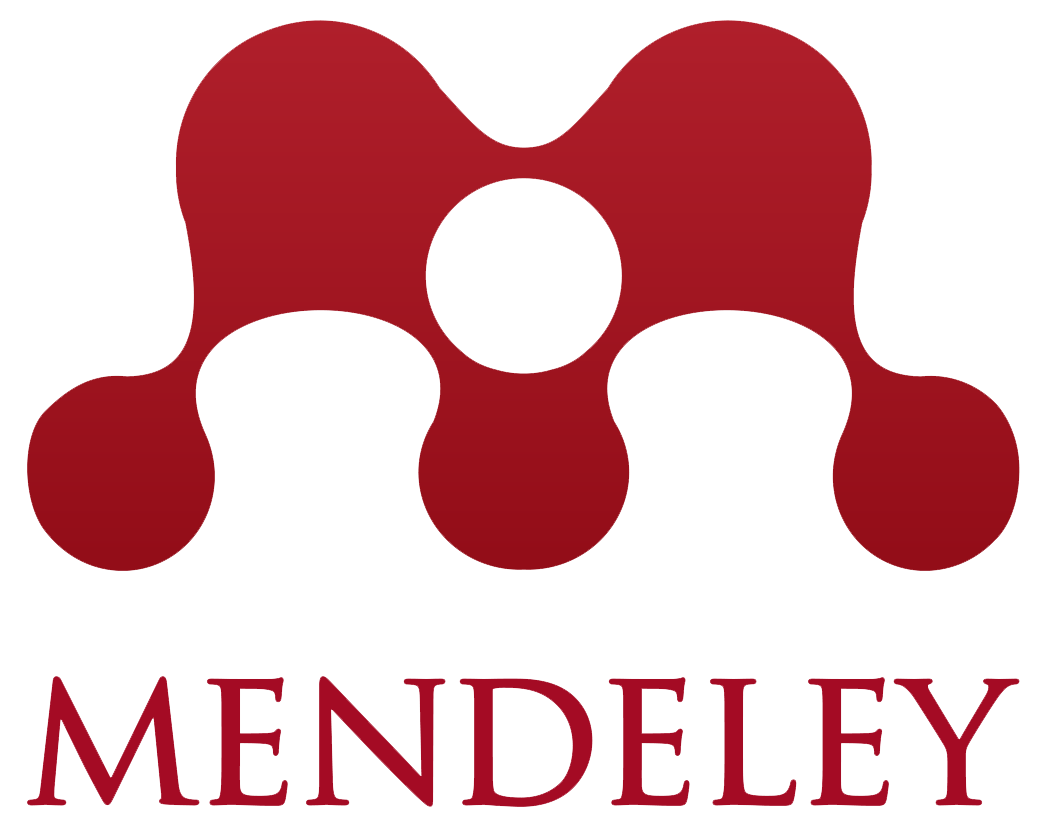Author Guidelines
Jurnal Keperawatan Merdeka published 2 (two) times each year (May and November) publishes research-based articles and literature-based papers in nursing science.
Uploaded articles are articles that have never been published before, and will never be published in whole or in part in a print/online version elsewhere. Full written articles as appropriate (article template):
Writing Guidelines:
TITLE
The title is written in Indonesian with a maximum of 15 words without including the year. The title is made clear, concise and attractive (Center, Times New Roman font 12, space 1).
Author's name is written: First Author1, Second Author2, Third Author3
Affiliation: Name of Institution, Province, Country
(correspondence author email: melati@university.ac.id)
ABSTRACT
Written in two languages, which contain: Background : Introduction (1-2 sentences), research objectives (1 sentence). Method: Materials and methods are written in 3-5 sentences. Results: research results are written in 3-5 sentences. Conclusion: Must be related to the research objectives and the conclusion hypothesis written in 1 sentence. Keywords: 3-5 words.
The abstract must be clear, providing a brief description of the problem under study. Abstract is written in one paragraph, avoid non-standard or uncommon references and abbreviations. If the abbreviation is important, it should be defined at the first mention. The number of sentences in the abstract is between 150 and 250 words. Abstract writing is preceded by using English then Indonesian. Write using Times New Roman, 11 point and 1 space.
INTRODUCTION (Times New Roman 12 point, Bold, 1.5 space)
The introduction contains the background of the research problem described by the inverted pyramid method starting from the global, national and local levels. References (relevant literature or research results) are written using the American Psychological Association (APA) format adapted to the bibliography. An example of using the research results set forth in the introduction: the learning culture of nurses about patient safety is influenced by nurse, interpersonal and institutional factors (Muliyadi et al, 2019). At the end of the introduction, the justification of the problem and the formulation of the research objectives are formulated.
The number of pages in the introduction is one to 1.5 pages or 3-5 paragraphs. Writing discussions using Times New Roman 11 point (upright) with 1 space. Each paragraph begins with a word that is indented into 5 digits. The final part of the introduction includes the research objectives.
METHOD (Times New Roman 12 point, Bold, 1.5 space)
Design (describe the design and approach used in the research). Population, Sample, and Sampling (specify the population, number of samples, sampling technique used in the study). Inclusion and exclusion criteria should be stated in detail. Research variables are described (including independent and dependent variables). Instruments (questionnaires used in research must be explained in detail). Each instrument presents information, number of questions, scale or category, explanation of how to ensure the instrument, validity and instrument references). Procedure (describe the research procedure briefly and in detail). Data analysis (describe the software used for analysis, type of analysis and variables analyzed). Ethical Clearance (EC explains ethical considerations). Research that uses tools and materials, needs to write down the specifications of the tools and materials used. Qualitative research (case studies, phenomenology, ethnography and others) needs to add a description of checking the validity of the research results.
Write using Times New Roman 11 point (upright) with 1 space. The paragraph begins with a word that is indented into 5 digits and there are no subtitles in this section, displayed in 1-2 paragraphs.
RESULTS (Times New Roman 12 point, Bold, spasi 1,5)
Results must be presented continuously starting from main results to supporting results. The unit of measure used must follow the applicable international system. The results of the study describe the characteristics of the research subjects, univariate analysis, bivariate analysis and multivariate analysis. Report the main results/findings including (where relevant) statistical significance levels and confidence intervals. Interpretation of research results is made in narrative form, tables and figures are made at most 3 tables/figures.
Write using Times New Roman 11 point (upright) with 1 space. The paragraph begins with a word that is indented into 5 digits and there are no subtitles in this section.
Table 1. Table and Image Format (according to the article template)
DISCUSSION (Times New Roman 12 point, Bold, 1.5 space)
The discussion section explains the research results that have been achieved or the review results that support or contradict the research results. The description of the discussion may not repeat the sentence of interpretation in the tables and graphs of the results of the analysis, however, it can be grouped for interpretation. The author explains problem solving and updates in writing this article or research. The author explains that this article is able to contribute to science, especially nursing.
Writing discussions using Times New Roman 11 point (upright) with 1 space. The paragraph begins with a word that is indented into 5 digits and does not use writing organization into sub-headings for each variable.
CONCLUSIONS AND SUGGESTIONS (Times New Roman 12 point, Bold, 1.5 space)
Conclusions can contain brief and clear descriptions related to hypotheses and new findings regarding results and discussion with reference to research objectives. Suggestions can contain recommendations on the research conducted. Suggestions can refer to practical actions, new theory development and/or further research.
Writing conclusions and suggestions using Times New Roman 11 point (upright) with 1 space. The paragraph begins with a word that is indented into 5 digits, does not use numbering and is in 1 paragraph.
ACKNOWLEDGMENTS (Times New Roman 12 point, Bold, 1.5 space)
Where appropriate, acknowledgments can be provided to the appropriate professional. Parties who provided assistance in this article such as technical, financial support, support from departments, institutions and those who contributed to the preparation of the report.
CONFLICT OF INTEREST (Times New Roman 12 point, Bold, 1.5 space)
Please ensure that a 'Declaration of Conflicting Interest' statement is included at the end of your manuscript, after the acknowledgment and before the reference. If there is no conflict, please state that 'The author certifies that there is no conflict of interest'.
REFERENCES (Times New Roman 12 point, Bold, 1.5 space)
The bibliography is written according to the American Psychological Association (APA) writing rules. All references used in writing are listed in the bibliography in accordance with the provisions of article citation. The author only lists the literature used and relevant. Reference sources of at least 80% are literature published in the last 10 years. Reference sources in the form of journals from articles of at least 60% of the total bibliography. The references used are primary sources in the form of research articles in journals or research reports, related books or articles from official sources. Articles published in independent nursing journals are suggested to be used as references. To maintain consistency in how to reference, quote and write a bibliography we recommend using standard reference applications such as Mendeley, Endnote, Zotero, RefWorks or Colwiz. Reference writing example:
Arthurs et. Al. (2014). The Effectiveness of Therapeutic Patient Education on Adherence to Oral Anti-Cancer Medicines in Adult Cancer
Patients 18 Years and Older in an Ambulatory Care Setting: a Systematic Review Protocol. JBI Database of Systematic Reviews and
Implementation Reports. Vol. 12:8
Aziz NM. (2007) Cancer survivorship research: state of knowledge, challenges and opportunities. Acta Oncol. 2007;46(4):417–
432. [PubMed]
Balitbangkes. (2018). Laporan Hasil Riset Kesehatan Dasar (Riskesdas). https://www.litbang.kemkes.go.id/laporan-riset-kesehatan-
dasar riskesdas/
Coleman, K., Austin, B. T., & Wagner, E. H. (2016). Evidence On The Chronic Care Model In The New Millennium: Thus far, the
evidence on the Chronic Care Model is encouraging, but we need better tools to help practices improve their systems. Health
Affairs, 28(1), 75–85. https://doi.org/10.1377/hlthaff.28.1.75.EvidenceEdith Pituskin, et al (2017) The Role of Cardio-Oncology in the Interprofessional Care of Adult Patients Receiving Cancer Therapy
PMID: 28941563 DOI: 10.1016/j.soncn.2017.08.010Husni, M., Romadoni, S., & Rukiyati, D. (2015). Hubungan Dukungan Keluarga dengan Kualitas Hidup Pasien Kanker Payudara di
Instalasi Rawat Inap Bedah RSUP Dr. Mohammad Hoesin Palembang Tahun 2012. Jurnal Keperawatan Sriwijaya, 2(2), 77–83.












